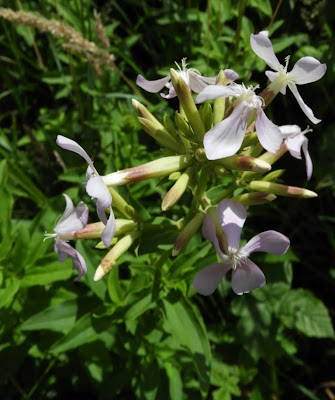When I photographed the White Campion I only took quick snaps as I did not intend to blog about it and then I got interested......
White Campion, Silene latifolia
This was introduced to Britain by Neolithic farmers and remains have been found on these and Bronze Age sites. It has a number of attractive names such as Summer Saucers in Somerset and Granny's Nightcap in Buckinghamshire. It has, however, a very dark side: pick it and your mother dies hence the name Mother-die in Cumbria. (Pick Red Campion, a native plant, not introduced, and your father will die.)
Its root can be used as a soap substitute for washing clothes and hair. It was also one of the ingredients in sixteenth century potpourri.
I saw this plant on the towpath of the Kennet and Avon Canal near Aldermaston.
It is dioecious with male and female flowers on separate plants. I think this is probably a female flower with 5 styles beginning to develop at the centre.
I think below is probably the male flower with 10 stamens, a few of which are visible here. Male plants also have more flowers which also makes it likely in this small colony this is the male.
The male calyx is 10 veined, the female 20 but it's not possible to use these photos to identify those. The plant is softly hairy, leaves lanceolate and opposite.
Petals are deeply cleft and there is a sweet scent in the evening attracting pollinating moths.
In the course of this post I have discovered a superb website English Wild Flowers, A Seasonal Guide by Ken Jones which has excellent photos of this and other plants. Link at the bottom. On this site you can find the definitive ID of the male/ female plants through photographs.
Soapwort, Saponaria officinalis
I know of two sites near where I live in the Wye Valley for this. One is near gardens in Tintern but this colony is much more in the wild on the bank of the Wye between Bigsweir and Llandogo and a mile or so from houses. The patch is at least twice as big this year as last, stretching for more than 3 metres. I suspect it may have originally arrived on floodwater.
There are dense clusters of pale pink flowers.There are 2 styles, 10 stamens and the calyx tube is long and split into 5 triangular teeth at the tip. It is often reddish.
Leaves are opposite, long-oval, near-stalkless and slightly bluish-green. There are 3-5 bold parallel veins. Most of these features can be seen here in these three photos- which were taken with the blog in mind and are I hope more useful!
This plant's English name, Soapwort, was given by the naturalist William Turner, who took it from Saponaria and Herba Fullonum the 'fullers' herb'. Possibly it was used in the manufacture of cloth in medieval times and certainly it was one of the ancient washing plants before soap was invented or generally used. A solution made from it was used as a disinfectant wash in thirteenth century Italy. Leaves were crushed, boiled in water and the liquid after straining gave an appreciable if not long lasting lather. Interestingly, Gerard regards it only as a garden ornamental but Culpepper describes the leaves laid on cuts and bruises. Bruisewort is a Somerset name for it.
Settlers took it with them to New England in the seventeenth century where the solution of water made soapy with leaves and roots was used against the unpleasant rash caused by Poison Ivy. It became naturalised in USA. Americans still give it the West Country name of Bouncing Bett.
I hope you have found this interesting and were not too frustrated by the lack of useful photos for White Campion. If you look at the recommended website for ID photos you won't be disappointed.
Exploring two members of the Caryophyllaceae family was key for me here.
Acknowledgements:
Stace 4
Harrap's Wild Flowers
Grigson The Englishman's Flora






No comments:
Post a Comment